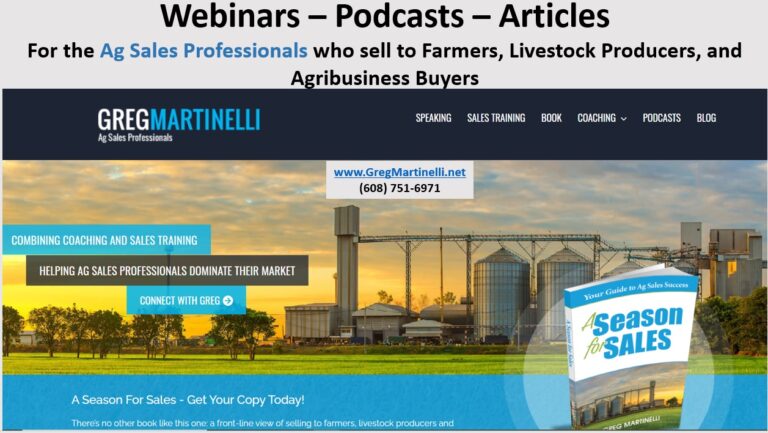Want to know how to win more sales?
Same as in baseball, beat the average
“I think you will enjoy the farm-life of Brian story at the end,” Greg
We’re all looking for a way to win more sales, be more effective with our customers and grow our business. To do that in sales, we have to compete. When you compete in sales, as in sports, it generates a lot of statistics. With home openers in the baseball season ramping up this week, I thought we needed to take a lesson from them to ramp up our selling season.
To compete and win, we don’t have to beat anyone by a mile. We would like to, but not necessary. We just have to continuously improve and beat them by a nose. Consistently improving over the average statistics will increase your sales success. No, there’s no guarantee, but the odds are in your favor.
-
Stat: 50% of the sales go to the first salesperson to contact the customer.
To do:
- Answer your phone, reply to texts, and reply to customer emails immediately. I am often amazed at salespeople who are on their phone constantly in meetings but can’t find time to reply to their customers or sales manager.
- Don’t skip your sales calls. Physically being in the same place as your customer is vastly different than a phone call.
- Follow up as fast as you can on leads. They were interested in a return call the minute they sent the email or phoned into your office. Ready, willing and able prospects with money in hand don’t get better over time. They just go somewhere else to get what they need.
- So what if you look like you were sitting around waiting for a call to come in. There will be plenty of times when you can’t reply immediately and then you can look like you are in such high demand that you can’t call back right away.
-
Stat: Only 2% of cold calls result in an appointment:
To Do:
- Get a better prospecting plan. Find better prospects by networking in the industry and warm up your cold call. When you connect with your customers at industry events and places outside of the buy-sell relationship, they see you as being a part of their industry. This should at least get you the first appointment.
- Give more free or introductory style offerings to gain more trust in your solutions. Prospects need to build their trust in you. The best way to do that is to build their involvement with your products gradually over time. Free content, trial runs, starter type products, and “gateway” services are great ways to engage a prospect. When we decide to spend our money, we all go to our research department (Google) and do our homework. We want to know if this is the type of person we can trust. I see salespeople struggle every day to take a prospect from unknown to a full product line customer in one meeting. In agribusiness, it rarely works that way. Build trust by keeping the ball moving forward with them.
- Build your brand to gain better prospects. No, not your company’s brand. I’m talking about your brand. See “You are the Brand to your customers”
-
Stat: The most memorable part of a presentation is the first five minutes and the last five minutes.
To do:
- Pre-call Plan – memorable openings and closings rarely happen by accident. If you are worried about sounding scripted, trust me, you will regret how bad you sound if you don’t pre-call plan.
- Launch with an impact – a statistic, a story or a bold statement. Separate the opening small talk with a story or bold statement that will set the stage for the selling discussion that is about to begin.
- End with a bang – a story. Here’s an interesting statistic on a statistic: After a presentation, on average only 5% of your audience will remember a statistic you said. However, an amazing 64% will remember a story you told. Tell more and better sales stories.
-
Stat: Each year, you will lose 14% of your customers.
To do:
- Develop a large list of prospects
- Segment them into hot, cold, top, etc.
- Start working on them consistently every day/week. Start with the highest priority prospects, which are those most likely to buy. Keep the ball rolling with the rest. And Never, Ever, Ever Drop the Ball. Did I emphasize not dropping the ball enough?
-
Stat: 80% of sales take five follow up calls. 44% of salespeople quit after the first call.
To do:
- The main reason is the salesperson has no relevant reason to go back. They went in and presented on their products. Failed to get any insight into this particular prospect’s operation. The prospect gave a standard resistance/objection. Now, our salesperson is lost.
- Step 1 is to search for a need. Don’t waste your first sales call by info dumping about all of your products and services. Spend as much time as humanly possible and socially appropriate for asking your prospect questions. The more you know about them, the more you can help them. And, the more you have to follow up on.
- Then position your solution. Since you’ve diagnosed and they have diagnosed, everyone is waiting to hear what remedy you might have for their individual problems.
- Then find ways to stay relevant… forever
- Find new ways to connect with your prospects
The farm life of Brian and 8 sales calls
Brian is a fourth-generation dairy producer with 750 acres of crops as well. On any given day, he starts early in the milk house and gets a short break after the second milking for supper. On this particular day, he is running hard. In between milking, he has some field work he needs to get done to spread fertilizer as planting is right around the corner. Also, on this particular day, he met with no less than 8 salespeople. Two were planned meetings (crop insurance and his ag lender). Two were impromptu but necessary meetings (feed company nutritionist and current seed salesperson). While four were unplanned and in Brian’s mind, not necessary (two seed company salespeople and two agronomy salespeople). However, that’s been his life for many years as both a grain producer and dairy farmer.
As he nods off to sleep that night, he has all but forgotten everything those 8 people said that day, except for one thing. One of those unplanned seed company salespeople told Brian a story of a producer in his area that was dealing with water hemp in his beans in a whole new way. Tomorrow, when Brian gets to the feed mill, he plans to check with a few of the local coffee crew that hangs out to see if they heard of this new technique.
Three days later, Brian hasn’t had any luck asking around about this technique. However, he’s interested and wants more info on it. So, he puts a call in for that salesperson to come back out and talk.




